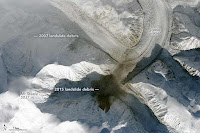About 150 000 tonnes of debris are believed to have been displaced following a landslide onto Lamplugh Glacier in Glacier Bay in southeast Alaska on Tuesday 28 June 2016. Nobody directly observed the event, however it was detected by the Alaska Earthquake Center as a Magnitude 2.9 event occurring slightly after 8.20 am local time. A flight over the area by Paul Swanson of the Mountain Flying Service revealed a rock exposure suggesting about 1200 m of mountainside had collapsed.
The scene of the 28 June 2016 Glacier Bay landslide. Paul Swanson/Mountain Flying Service.
Without access to the site determining the cause of the event is not likely to be possible, and the cause of very large landslides and avalanches is often very difficult to determine even with close inspection. Such events are generally caused by the sudden release of a source of tectonic stress that has built up over a long period of time, with the actual trigger often being a very small event, the traces of which are typically wiped out by a large landslide.
See also...
 Eruption on Mount Pavlof causes severe disruption to flights over Alaska. Mount Pavlof, a 2.5 km high stratovolcano (cone-shaped volcano made up
of layers of ash and lava) on the Alskan Peninsula, underwent a
significant...
Eruption on Mount Pavlof causes severe disruption to flights over Alaska. Mount Pavlof, a 2.5 km high stratovolcano (cone-shaped volcano made up
of layers of ash and lava) on the Alskan Peninsula, underwent a
significant... Magnitude 4.4 Earthquake off the coast of British Columbia. The West Coast and Alaska Tsunami Warning Center reported
a Magnitude 4.4 Earthquake roughly 90 km off the northwest tip of
Vancouver...
Magnitude 4.4 Earthquake off the coast of British Columbia. The West Coast and Alaska Tsunami Warning Center reported
a Magnitude 4.4 Earthquake roughly 90 km off the northwest tip of
Vancouver... Landslide displaces 45 000 tons of debris on Mount Steel, southwestern Yukon Territory, Canada. On Monday 11 October 2015 Colin Stark and Göran Ekström of the Lamont-Doherty Earth Observatory and Department of Earth...
Landslide displaces 45 000 tons of debris on Mount Steel, southwestern Yukon Territory, Canada. On Monday 11 October 2015 Colin Stark and Göran Ekström of the Lamont-Doherty Earth Observatory and Department of Earth...
Follow Sciency Thoughts on Facebook.

